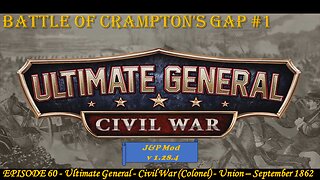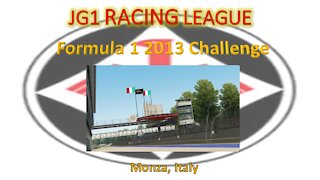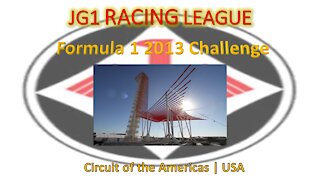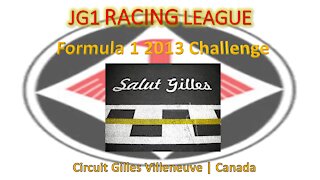Premium Only Content

Race 1 - 2 | JG1 Racing League | BMW M1 ProCar | Miami-Bayside | USA
\\\ Notice - These videos are intended for a mature audience only. ///
Race 1 - 2 | JG1 Racing League | BMW M1 ProCar | Miami-Bayside | USA
Let me know if you like ANNOUNCER BOT, the guy calling the race!!
Information and register here: http://76.235.193.133:8772/championships
***Join us on discord at: https://discord.gg/qcgZTMs
BMW M1 Procar Championship
The BMW M1 Procar Championship, sometimes known simply as Procar, was a one-make auto racing series created by Jochen Neerpasch, head of BMW Motorsport GmbH, the racing division of automobile manufacturer BMW. The series pitted professional drivers from the Formula One World Championship, World Sportscar Championship, European Touring Car Championship, and other international series against one another using identically modified BMW M1 sports cars.
Billed as an opportunity to see a mix of drivers from various motorsport disciplines, the championship served as support races for various European rounds of the 1979 Formula One season, with Formula One drivers earning automatic entry into the Procar event based on their performance in their Formula One cars. Austrian Niki Lauda won the inaugural championship. In 1980, the series held some events outside of Formula One schedule, and was won by Brazilian Nelson Piquet. BMW chose not to continue the championship in 1981 to concentrate on their entrance into Formula One.
Origin
Jochen Neerpasch, the head of BMW's Motorsports division, was the first to propose the idea of a one-make championship. The division had started construction of the first sports car for BMW in 1978, the M1, and had planned from the start to enter the new sports car in the World Sportscar Championship in 1979, as well as offering the cars to customers for other series. BMW Motorsport planned to build M1s to meet regulations known as Group 5, but a rule change instituted by the Fédération Internationale du Sport Automobile (FISA) in 1977 altered the requirements for Group 5. The new regulations required a minimum of 400 examples of the M1 to be built to meet Group 4 regulations before the car could be further homologated for the Group 5 category.
Development of the Group 4 racing car was already under way at the time of the regulation change. Neerpasch believed that rather than delaying their racing program until 400 road cars had been built, racing cars could be built at the same time since they too counted toward the 400 example minimum. A one-make series consisting of the M1 racing cars intended for Group 4 was devised by Neerpasch since the racing cars could not yet legally compete elsewhere, while at the same time allowing BMW to develop the race cars through experience.
To attract drivers to the series, Neerpasch entered into discussions with Max Mosley. Mosley was the head of March Engineering, a constructor which BMW was partnered with in their factory efforts in the European Formula Two Championship. Mosley was at the time a member of the Formula One Constructors Association, and was able to use his position to convince other Formula One constructors to support the use of Neerpasch's one-make series as a support race for European Formula One events. A ruling and organisation body for the series, known as The Procar Association, was set up by BMW and approved by FISA.
Format
With the Procar Championship announced in spring 1978 at the official unveiling of the M1 road car, Neerpasch and the newly formed Procar Association laid out regulations for the 1979 season. Races were planned for the middle of the Formula One season, when the championship remained in Europe for several months. Practice and qualifying were held on Friday of the race weekend, while the race itself occurred on Saturday. The winner of each race received US $5,000, second place received $3,000, and third place $1,000. Races varied in length, but each lasted for approximately half an hour.
To attract Formula One drivers to the championship, seats were guaranteed in the Procar races by cars which were entered by the factory BMW team. The five fastest Formula One drivers from Friday practice were assigned to the factory team, and were even guaranteed the first five grid positions for the Procar race, regardless of their qualifying times in the cars. This not only guaranteed Formula One driver participation, but also allowed for a variety of drivers to be seen over the course of the season. However, because the series ran Goodyear tyres, several Formula One drivers were not allowed to compete due to contractual obligations with competing tyre manufacturer Michelin. As Scuderia Ferrari and Renault were selling roadcars themselves, they did not allow their Formula One drivers to participate and implicitly endorse BMW.
Other teams were allowed to participate, assigning a variety of sportscar and touring car drivers as well as Formula One drivers who had not earned spots in the factory cars. Points were awarded to the top ten finishers, starting with 20 points and decreasing down to 15, 12, 10, 8, 6, 4, 3, 2, and finally 1 for the nine remaining drivers. An overall championship was awarded to the driver who had accumulated the most points at the end of the season. A new M1 road car was awarded to the championship winner.
Cars
All cars used in the Procar Championship were built to identical standards, although their origins varied. BS Fabrications constructed five cars for the BMW factory team, while cars for other competitors were constructed by the British Formula Two team Project Four Racing (led by Ron Dennis) and the Italian constructor Osella. The racing cars, designed to meet Group 4 technical regulations, shared only some basics from the M1 road cars.
For the M1's exterior, simple modifications were made to adapt the car aerodynamically. A deep spoiler was added under the nose of the car, while an adjustable wing was added on two mounts at the rear of the engine cover. The arches for the wheels were extended outward to shroud the wider 28 centimetres (11 in) wheels in the front, and 32 cm (12.6 in) wheels at the rear. The alloy wheels, designed by Campagnolo, featured a central locking nut and mimicked the straked design of the production car's wheels. Inside, the car featured no finishing or luxuries from the road car, only a rollcage for driver protection. The glass windows were replaced with clear plastic.
Mechanically, the Procar M1s were extensively modified to meet the requirements of circuit racing. The standard M1 featured the cast iron block BMW M88 straight-6 with 3,453 cubic centimetres (210.7 cu in) displacement. Modified into the M88/1 by a team led by Paul Rosche, it was capable of producing 470 horsepower at 9000 rpm, compared to 277 hp from the standard M1's engine. The 5-speed ZF gearbox housing from the road car was retained, but with multiple gear ratios allowed, as well as its own oil cooler.
The suspension was entirely new, adding adjustable anti-roll bars. The brakes were redesigned to adapt the use of a driver-adjustable brake pressure balance, while the servo-activated braking system was removed. A racing steering rack was used in place of the standard power steering unit. Pneumatic jacks were later added to the cars in the 1980 season to allow for quicker pit stops. Goodyear racing tires were used on all cars. All other non-essential items from the road car were not included, bringing the Procar M1's weight down to 1,020 kilograms (2,250 lb). The performance of the Procar M1s was increased to a top speed of 311 kilometres per hour (193 mph) dependent upon gear ratios, and acceleration from 0–100 km/h (62 mph) in 4.3 seconds. Each Procar M1 cost approximately US $60,000.
-
 54:25
54:25
CAPT JAKE's Sim Racing, and Gaming
1 day agoUltimate General - Civil War (Col) - Union - EPISODE 60 - Battle of Crampton's Gap #1
18 -
 45:12
45:12
CAPT JAKE's Sim Racing, and Gaming
3 years agoRace 3 - 4 | JG1 Racing League | BMW M1 ProCar | Suzuka 1988 | Japan
76 -
 48:51
48:51
CAPT JAKE's Sim Racing, and Gaming
3 years agoRace 6 | JG1 Racing League | Formula 1 2013 Challenge | Spa | Belgium
40 -
 45:10
45:10
CAPT JAKE's Sim Racing, and Gaming
3 years agoRace 7 | JG1 Racing League | Formula 1 2013 Challenge | Monza | Italy
71 -
 46:09
46:09
CAPT JAKE's Sim Racing, and Gaming
3 years agoRace 10 | JG1 Racing League | Formula 1 2013 Challenge | Interlagos | Brazil
20 -
 33:16
33:16
CAPT JAKE's Sim Racing, and Gaming
4 years agoJG1 Racing League | Race 7 | BTCC - World Challenge | Knockhill | Scotland
96 -
 45:51
45:51
CAPT JAKE's Sim Racing, and Gaming
3 years agoRace 9 | JG1 Racing League | Formula 1 2013 Challenge | Circuit of the Americas | USA
77 -
 34:22
34:22
CAPT JAKE's Sim Racing, and Gaming
4 years agoJG1 Racing League | Race 6 | BTCC - World Challenge | Dijon-Prenois GP | France
51 -
 48:19
48:19
CAPT JAKE's Sim Racing, and Gaming
4 years agoRace 4 | JG1 Racing League | Formula 1 2013 Challenge | Silverstone Circuit GP| UK
28 -
 46:18
46:18
CAPT JAKE's Sim Racing, and Gaming
4 years agoRace 3 | JG1 Racing League | Formula 1 2013 Challenge | Circuit Gilles Villeneuve | CA
39